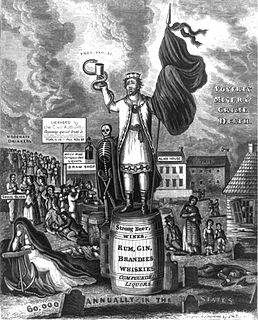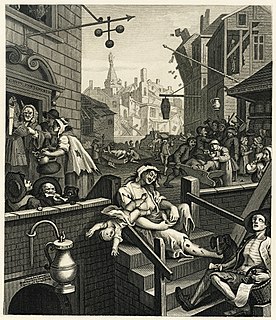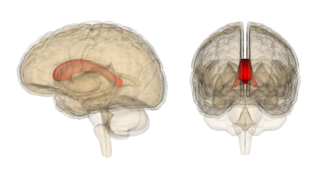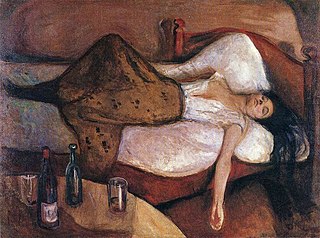Related Research Articles

Alcoholism, more appropriately referred to as alcohol use disorder (AUD), is, broadly, any drinking of alcohol that results in mental and/or physical health problems ranging anywhere from mild and imperceptible without special testing to severe and grossly overt. The disorder was previously divided into two types: alcohol abuse and alcohol dependence. In a medical context, alcoholism is said to exist when two or more of the following conditions are present: a person drinks large amounts of alcohol over a long time period, has difficulty cutting down, acquiring and drinking alcohol takes up a great deal of time, alcohol is strongly desired, usage results in not fulfilling responsibilities, usage results in social problems, usage results in health problems, usage results in risky situations, withdrawal occurs when stopping, and alcohol tolerance has occurred with use. Alcohol use can affect all parts of the body, but it particularly affects the brain, heart, liver, pancreas and immune system. Alcoholism can result in mental illness, delirium tremens, Wernicke–Korsakoff syndrome, irregular heartbeat, an impaired immune response, liver cirrhosis and increased cancer risk. Drinking during pregnancy can result in fetal alcohol spectrum disorders. Women are generally more sensitive than men to the harmful effects of alcohol, primarily due to their smaller body weight, lower capacity to metabolize alcohol, and higher proportion of body fat. In a small number of individuals, prolonged, severe alcohol abuse ultimately leads to frank dementia.

Alcohol abuse encompasses a spectrum of unhealthy alcohol drinking behaviors, ranging from binge drinking to alcohol dependence, in extreme cases resulting in health problems for individuals and large scale social problems such as alcohol-related crimes.

Disulfiram is a drug used to support the treatment of chronic alcoholism by producing an acute sensitivity to ethanol. Disulfiram works by inhibiting the enzyme acetaldehyde dehydrogenase, causing many of the effects of a hangover to be felt immediately following alcohol consumption. Disulfiram plus alcohol, even small amounts, produces flushing, throbbing in the head and neck, a throbbing headache, respiratory difficulty, nausea, copious vomiting, sweating, thirst, chest pain, palpitation, dyspnea, hyperventilation, fast heart rate, low blood pressure, fainting, marked uneasiness, weakness, vertigo, blurred vision, and confusion. In severe reactions there may be respiratory depression, cardiovascular collapse, abnormal heart rhythms, heart attack, acute congestive heart failure, unconsciousness, convulsions, and death.

Heavy consumption of ethanol can cause severe detrimental effects. Health effects associated with alcohol intake in large amounts include an increased risk of alcoholism, malnutrition, chronic pancreatitis, alcoholic liver disease and cancer. In addition, damage to the central nervous system and peripheral nervous system can occur from chronic alcohol abuse. Even light and moderate alcohol consumption increases risk for certain types of cancer.
Alcohol dependence is a previous psychiatric diagnosis in which an individual is physically or psychologically dependent upon alcohol.

Alcoholic polyneuropathy is a neurological disorder in which peripheral nerves throughout the body malfunction simultaneously. It is defined by axonal degeneration in neurons of both the sensory and motor systems and initially occurs at the distal ends of the longest axons in the body. This nerve damage causes an individual to experience pain and motor weakness, first in the feet and hands and then progressing centrally. Alcoholic polyneuropathy is caused primarily by chronic alcoholism; however, vitamin deficiencies are also known to contribute to its development. This disease typically occurs in chronic alcoholics who have some sort of nutritional deficiency. Treatment may involve nutritional supplementation, pain management, and abstaining from alcohol.

Alcohol tolerance refers to the bodily responses to the functional effects of ethanol in alcoholic beverages. This includes direct tolerance, speed of recovery from insobriety and resistance to the development of alcoholism.

Alcohol has a number of effects on health. Short-term effects of alcohol consumption include intoxication and dehydration. Long-term effects of alcohol consumption include changes in the metabolism of the liver and brain and alcoholism. Alcohol intoxication affects the brain, causing slurred speech, clumsiness, and delayed reflexes. Alcohol stimulates insulin production, which speeds up glucose metabolism and can result in low blood sugar, causing irritability and possibly death for diabetics. There is an increased risk of developing an alcohol use disorder for teenagers while their brain is still developing. Adolescents who drink have a higher probability of injury including death.
The modern disease theory of alcoholism states that problem drinking is sometimes caused by a disease of the brain, characterized by altered brain structure and function.

Marchiafava–Bignami disease is a progressive neurological disease of alcoholism, characterized by corpus callosum demyelination and necrosis and subsequent atrophy. The disease was first described in 1903 by the Italian pathologists Amico Bignami and Ettore Marchiafava in an Italian Chianti drinker. In this autopsy, Marchiafava and Bignami noticed that the middle two-thirds of the corpus callosum were necrotic. It is very difficult to diagnose and there is no specific treatment. Until 2008 only around 300 cases had been reported. If caught early enough, most patients survive.
John Hundale Lawrence was an American physicist and physician best known for pioneering the field of nuclear medicine.
A drug-related blackout is a phenomenon caused by the intake of any substance or medication in which short-term and long-term memory creation is impaired, therefore causing a complete inability to recall the past. Blackouts are frequently described as having effects similar to that of anterograde amnesia, in which the subject cannot recall any events after the event that caused amnesia.

A hangover is the experience of various unpleasant physiological and psychological effects following the consumption of alcohol, such as wine, beer, and distilled spirits. Hangovers can last for several hours or for more than 24 hours. Typical symptoms of a hangover may include headache, drowsiness, concentration problems, dry mouth, dizziness, fatigue, gastrointestinal distress, absence of hunger, light sensitivity, depression, sweating, nausea, hyper-excitability, irritability, and anxiety.
The impact of alcohol on aging is multifaceted. Evidence shows that alcoholism or chronic alcohol consumption can cause both accelerated (or premature) aging – in which symptoms of aging appear earlier than normal – and exaggerated aging, in which the symptoms appear at the appropriate time but in a more exaggerated form. The effects of alcohol abuse/misuse on the aging process include hypertension, cardiac dysrhythmia, cancers, gastrointestinal disorders, neurocognitive deficits, bone loss, and emotional disturbances especially depression. On the other hand, research also shows that drinking moderate amounts of alcohol may protect healthy adults from developing coronary heart disease. The American Heart Association cautions people not to start drinking, if you are not already drinking.

The short-term effects of alcohol consumption – due to drinking beer, wine, distilled spirits or other alcoholic beverages – range from a decrease in anxiety and motor skills and euphoria at lower doses to intoxication (drunkenness), stupor, unconsciousness, anterograde amnesia, and central nervous system depression at higher doses. Cell membranes are highly permeable to alcohol, so once alcohol is in the bloodstream, it can diffuse into nearly every cell in the body.
Alcohol consumption in Russia remains among the highest in the world. According to a 2011 report by the World Health Organization, annual per capita consumption of alcohol in Russia was about 15.76 litres, the fourth-highest volume in Europe. It has dropped to less than 10 litres as of 2019. Another dangerous trait of Russian alcohol consumption pattern was the high volume of spirits compared with other alcoholic drinks.

Alcohol, sometimes referred to by the chemical name ethanol, is a psychoactive drug that is the active ingredient in drinks such as beer, wine, and distilled spirits. It is one of the oldest and most common recreational substances, causing the characteristic effects of alcohol intoxication ("drunkenness"). Among other effects, alcohol produces a mood lift and euphoria, decreased anxiety, increased sociability, sedation, impairment of cognitive, memory, motor, and sensory function, and generalized depression of central nervous system function. Ethanol is only one of several types of alcohol, but it is the only type of alcohol that is found in alcoholic beverages or commonly used for recreational purposes; other alcohols such as methanol and isopropyl alcohol are significantly more toxic. A mild, brief exposure to isopropanol, being only moderately more toxic than ethanol, is unlikely to cause any serious harm. Methanol, being profoundly more toxic than ethanol, is lethal in quantities as small as 10-15 milliliters.
Alcoholism is a chronic disease characterized by trouble controlling the consumption of alcohol, dependence, and withdrawal upon rapid cessation of drinking. According to ARDI reports approximately 88,000 people had alcohol-related deaths in the United States between the years of 2006 and 2010. Furthermore, chronic alcohol use is consistently the third leading cause of death in the United States. In consequence, research has sought to determine the factors responsible for the development and persistence of alcoholism. From this research, several molecular and epigenetic mechanisms have been discovered.
Sujata Tewari (1938–2000) was an Indian-American neuroscientist known for her work with Ernest Noble that demonstrated that chronic alcohol consumption inhibits protein metabolism in the brains of mice.

SAFit2 is a drug which acts as a potent and selective inhibitor of the signalling factor FK506 binding protein 51 (FKBP51), which is involved in the downstream response to glucocorticoid release in the body. Since elevated glucocorticoid levels are a characteristic marker of chronic stress, blocking glucocorticoid signalling pathways using SAFit2 has been shown to counteract many of the associated symptoms such as obesity, chronic pain, depression and anxiety, and addiction. While SAFit2 itself is a relatively large molecule and is unlikely to have suitable properties to be developed for medical use, it has demonstrated that inhibition of FKBP51 may be a useful therapeutic approach for alleviating consequences of long-term chronic stress and pain.
References
- ↑ "In Memoriam: Dr. Ernest Noble". National Institute on Alcohol Abuse and Alcoholism. 2017-11-03. Retrieved 2018-07-12.
- ↑ Noble, Ernest P.; Tewari, Sujata (1973-04-01). "Protein and Ribonucleic Acid Metabolism in Brains of Mice Following Chronic Alcohol Consumption*". Annals of the New York Academy of Sciences. 215 (1): 333–345. Bibcode:1973NYASA.215..333N. doi:10.1111/j.1749-6632.1973.tb28287.x. ISSN 1749-6632. PMID 4513678. S2CID 45107505.
- ↑ Gottschalk, Louis A. "Sujata Tewari". University of California: In Memoriam 2001.
- ↑ "Ernest Noble". Guggenheim Foundation. Retrieved 2018-07-12.
| This biographical article about an American chemist is a stub. You can help Wikipedia by expanding it. |